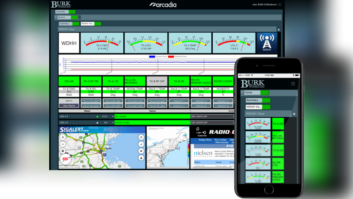It’s tragic and sobering when an engineering brother loses his life at the hands of a broken transmitter.
Jerry Campbell, a 73-year-old contract engineer known throughout the Mississippi broadcast community, died while working on the WDMS(FM) transmitter in Greenville, the morning of Aug. 19. Jerry was the founder and long-time supporter of Rebel Radio at the University of Mississippi in Oxford. Our belated sympathies and condolences go out to his family.

Although the incident is being investigated as I write, we’ll probably never know exactly what happened that morning; there apparently were no immediate witnesses. It is presumed Jerry came in contact with an energized component while troubleshooting a CCA transmitter with the back door open.
Of all the equipment that broadcast engineers maintain, transmitters present the highest risk for shock and electrocution because of the high voltages employed. Solid-state transmitters are not exempt.
This kind of fatal accident remains infrequent in our business. That may be surprising, especially with fewer properly trained engineers working on transmitters in the field. At the same time, it should never really have to happen if proper safety precautions are observed.
CLOSE ENCOUNTERS OF A DANGEROUS KIND
Most engineers can tell memorable stories of their own personal encounters with serious electrical shocks, RF burns and perhaps even a near-miss electrocution. I recall being knocked into brief unconsciousness and falling to the floor after touching 800 Volts inside a ham transmitter while still in high school.
As a young chief engineer working alone on an RCA AM rig, I grabbed onto 4,000 Volts thinking the front door interlock had shut off the transmitter. The switch mechanism had failed. After another knock-down to the floor with no feeling in my entire right arm, I looked up to see the transmitter back on the air. My then-girlfriend DJ was happily reading a local newscast. I recall thinking a few minutes later that the local news might easily have included my own obituary.
Hazardous duty has always been part of the unwritten job description for station and contract engineers working on anything that uses significant electrical power. Since solid-state has now eliminated the higher voltage threats of equipment using vacuum tubes, too many engineers nowadays assume that nothing except the AC primary power side of their operations can be dangerous. Unfortunately, there are other hazards lurking.
HUMANS VS. ELECTRICITY
Any piece of equipment or circuit carrying about 50 Volts or higher with a sufficient current source has the potential to kill a person. Areas we think are “safe” can be dangerous. The 100 Volts of a telco POTS ringer signal has been known to stop hearts. Those who wear pacemakers are especially vulnerable.
The path that electricity decides to take through the body will determine whether one survives contact with a lethal voltage source. Usually it finds the lowest resistance course to a common or ground point to complete the circuit. If that path comes close enough or is strong enough to disrupt the sinus rhythm signaling that commands the heart to beat, it simply stops beating. Quick application of CPR after such an encounter may be the only way to save the victim’s life.
In my own close encounters with near-death, I can only conclude that the resistance path to ground in each case was along the surface of the skin where lower resistance was created by perspiration. Whatever the reason, I was lucky. Had the electrons flowed deeper through the central nervous system, I probably would not be here today writing about it.
10-POINT SAFETY SERMON
Since then, I’ve gained a much more profound respect for high voltage and have modified my approach to troubleshooting.
For anyone who works on any piece of equipment that contains lethal voltages, I offer the following checklist of suggestions and precautions to keep in mind:
- Treat any piece of failed high-voltage gear you want to troubleshoot like a ticking time bomb that has to be deactivated. Safety is the number one priority.
- Study the schematics or block diagram and external connections first so you know where high-voltage points, the power sources and disconnects are located. Isolate the unit from all unnecessary external connections if possible.
- Even with the primary power off and the outside world disconnected, large capacitors and inductors can store lethal energy that must be extinguished with a shorting or Jesus stick.
- Troubleshooting while power is on with interlocks cheated and doors open is always the riskiest and most dangerous environment you can create. Consider all other methods of finding the problem first without resorting to cheating safety devices.
- Before you decide to touch anything that had been energized during normal power-up operations, ask yourself twice: Am I certain there is no active or residual energy present? Hit the spot with the Jesus stick again to make sure. I’ve done that a few times and was surprised but grateful to draw fire and trip breakers. Was this the step Jerry Campbell did not complete?
- If internal circuit points must be tested with a multi-meter, never attempt to do that holding the test leads on an active circuit near high voltage. Turn off the power and hit your test points with a few strikes of the Jesus stick. Then attach the alligator clip ends of the test leads and place or suspend the leads and the multi-meter in a safe isolated position where you can see it. Then turn on the power and observe the results with hands in pockets.
- If it’s absolutely necessary to work “hot,” always work with only one hand. Holding the chassis or cabinet with the idle hand while working with the other provides an easy path for circuit completion through the upper body across the heart.
- When troubleshooting anything near or containing high voltage, always wear a good pair of shoes with thick rubber or neoprene soles. That gives you more effective insulation above ground.
- Whenever you encounter an off-air emergency caused by a lightning storm, wait until the storm has passed before getting close to tower bases and transmitting equipment to do troubleshooting. The same applies when you are very tired. Wait until you are fresh before tackling a difficult transmitter repair.
- When you have to do potentially risky work at a transmitter site, especially one in a remote area, it’s prudent to take another engineer along to help; or at least someone who knows CPR and can assist if any kind of accident should occur.
THE BUDDY SYSTEM
Since Jerry’s accident, #10 has been the topic of quite a bit of Web chatter on various engineering and SBE listservs. The primary issue of concern is whether employers should require a second engineer or assistant to accompany the primary engineer when doing any risky work at transmitter sites including off-air emergencies.
Power and electrical companies have long required the presence of at least two electricians when troubleshooting or carrying out other risky procedures around high-voltage equipment. OSHA does not address the issue with regard to businesses like broadcasting where a designated employee is charged with maintaining equipment that contains lethal voltages.

iStockphoto/Isaac Koval A few of the larger group broadcasters understand these risks and have instituted a policy that requires two engineers be engaged in higher-risk transmitter site work including emergencies. Union contracts require it.
That might work for companies that still retain multi-person engineering staffs. But for most stations and sole-proprietor contractors, it’s a luxury that is not realistically available. Station managers are reluctant to require the second body since it increases costs and has not been necessary in the past.
Some of the seasoned veteran engineers responsible for transmitter plants have been working alone for so long, they prefer it that way. Having another person present can slow things down and actually cause more distractions, they say.
Such venerable servants are becoming scarce and are not easily replaced.
SHARE THE WEALTH
Unless the knowledgeable vets start sharing their skills and know-how before they retire or move on, even larger stations may have to resort to a local contractor or a transmitter manufacturer’s field engineer to provide on-site expertise. Take an assistant along for emergency transmitter site repairs. This is one of the best ways younger replacement engineers can learn the tricks of the trade from the masters.
If you are an aspiring chief engineer who would love to get more training from your soon-to-retire boss, work out an agreement with him and the manager to have you included whenever important transmitter work must be done, especially the emergencies. You may not get management to make it a written policy, but the results will be similar and will certainly benefit everyone.
If you’re a solo engineer already being called on to fix dead transmitters and sometimes feel a little uncomfortable dealing with that challenge alone, find a knowledgeable fellow engineer in your area to assist when necessary. Getting your manager to approve this as an occasional outside expense should not be that difficult.
Reread and follow the 10-point approach above and you should be just fine. Think carefully before making any moves inside a misbehaving transmitter plant; and by all means, stay safe.
Guy Wire is the pseudonym for a veteran broadcast engineer.












